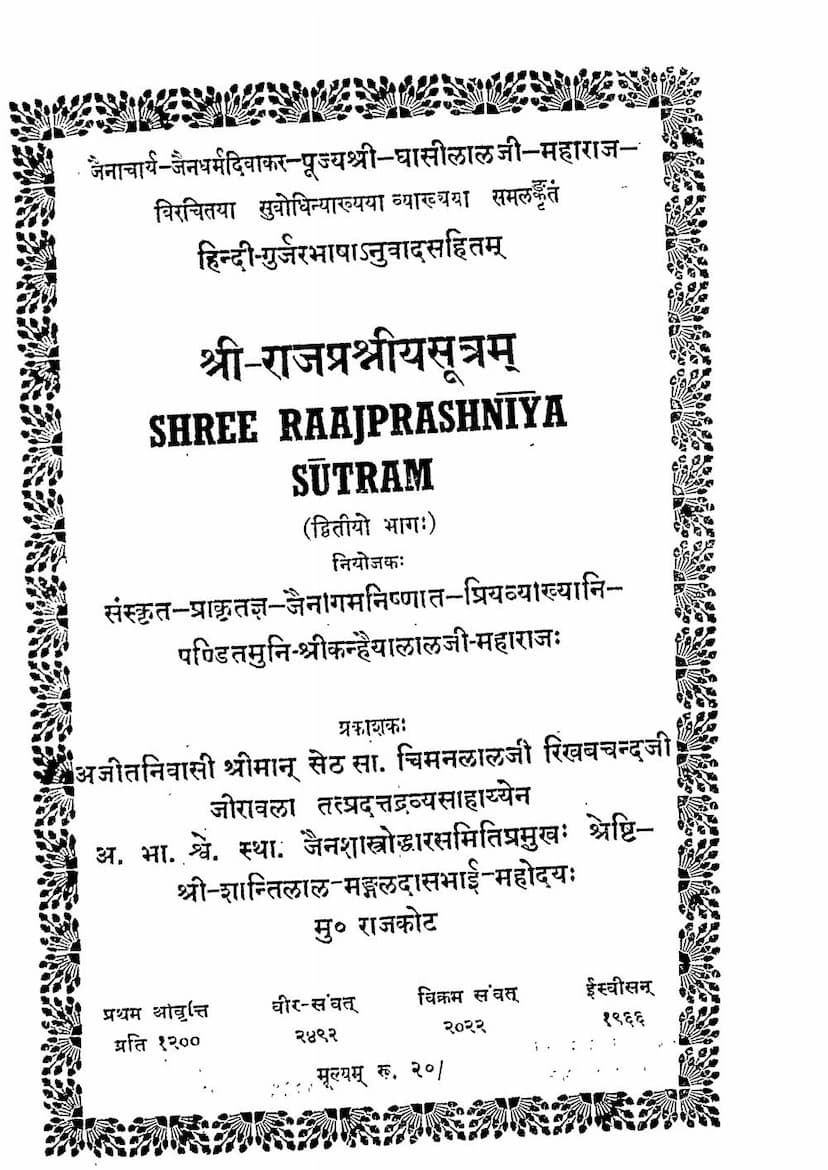Rajprashniya Sutra Part 02
Added to library: September 2, 2025

Summary
Based on the provided text, here's a comprehensive summary of the Rajprashniya Sutra Part 02, authored by Ghasilal Maharaj and published by A B Shwetambar Sthanakwasi Jain Shastroddhar Samiti:
Overall Nature of the Text:
The text is the second part of the Shree Raajprashniya Sutram, a Jain scripture, accompanied by the Subodhini commentary. It is presented in Hindi and Gujarati, with original Sanskrit/Prakrit verses. The work is dedicated to elucidating the teachings of Jainism, specifically focusing on profound spiritual and philosophical concepts. The preface highlights the importance of preserving ancient Jain scriptures and acknowledges the generous contribution of Seth Sh. Chimanlalji Rikhabchandji of Ajitvale for its publication.
Key Content and Themes (Based on available text):
While the provided text mainly consists of the introductory pages, publisher information, dedication, and a significant portion dedicated to "Shree Shimanalji Sakar Lavala Ka Parichay" (Introduction of Shri Chimanlalji Rikhabchandji of Jivala) and "Sudhi Patra" (Errata), it offers glimpses into the likely content of the scripture itself through the introduction and errata:
- Theological and Philosophical Discussions: The preface and the introduction to the donors suggest the text delves into Jain philosophy and teachings, likely covering aspects of karma, soul, liberation, and ethical conduct. The mention of "Jain Dharam Diwakar" (Sun of Jainism) for the author indicates a focus on core Jain doctrines.
- Narrative Portrayal of Jain History and Figures: The detailed introduction of the Chimanlalji Rikhabchandji family, tracing their lineage through prominent historical figures like Doshi Bhikhuji and their philanthropic activities, suggests that the Rajprashniya Sutra might contain narratives or discussions related to the lives and contributions of noble Jain individuals and families throughout history. The emphasis on their religious, social, and national service indicates a historical and biographical dimension.
- Linguistic and Textual Accuracy: The extensive "Sudhi Patra" (Errata) section reveals a meticulous effort by the publishers to ensure the accuracy of the text. It lists numerous corrections made to the original verses, reflecting a commitment to providing a faithful and scholarly edition of the scripture. The corrections span across various Angas and Sutras, indicating the comprehensive nature of the underlying text being discussed.
- The "Rajprashniya" Aspect: The title "Rajprashniya" (Royal Questions) suggests that the text might be structured around questions posed by royalty or prominent individuals to Jain monks or scholars, with the scripture providing the answers. This format implies a didactic and explanatory approach to Jain teachings, addressing potentially complex queries. The excerpt mentioning "Gautam Swami's question" and "Bhagwan's answer" in relation to "Suryabhadev" (Pages 15 & 48) strongly supports this interpretive aspect. The early pages also mention a question about "Suryabhdev's Riddhi" (supernatural powers).
- Genealogy and Family History: The detailed account of the Doshi family, their association with royalty, and the life stories of Shri Chimanlalji and Rikhabchandji, including their mother's resilience, suggest a biographical and genealogical element within the text or its accompanying introduction.
Introduction of Patrons:
The text extensively introduces Shri Chimanlalji Rikhabchandji 'Jirawala'. It highlights the significant role of the Oswal community in Indian culture, their wisdom, foresight, bravery, and sacrifices. It specifically mentions their contributions to India's history and freedom struggle. The Doshi family, a prominent clan within the Oswal community, is praised for its historical contributions, including the patronage of public works like the Rajsamudra pond under Maharana Rajsinghji. Shri Chimanlalji and Rikhabchandji are described as generous donors and hidden gems in the Jain community, using their wealth for philanthropic endeavors. Their family tree is also presented, showing their lineage from Gulabchandji, who was known as 'Jirawala'. The text also mentions their mother, Khetubai, and their children and grandchildren, highlighting a strong familial and community presence.
Key Figures Mentioned:
- Ghasilal Maharaj: The author of the Subodhini commentary.
- Pujyashri Ghasilalji Maharaj: Also mentioned as the author.
- Pundit Muni Shri Kanhaiyalalji Maharaj: The planner/editor of the Sanskrit and Prakrit text.
- Seth Sh. Chimanlalji Rikhabchandji 'Jirawala': The primary patron of the publication.
- Gautam Swami: The questioner in the sutra.
- Bhagwan Mahavir: Mentioned in the context of teaching.
- Bhagwan Keshiswami: Mentioned in the context of questions.
- Suryabhadev: A divine being whose powers and past lives are discussed.
- Pradeshi Raja: A significant character in the narrative, likely a ruler whose actions or questions drive the discourse.
- Chitra Sarathi: A loyal attendant of Pradeshi Raja, involved in his interactions with Keshikumarsraman.
- Keshikumarsraman: A Jain monk or spiritual figure who imparts knowledge.
- Surya Kanta Devi: The queen of Pradeshi Raja.
- Surya Kanta Kumar: The son of Pradeshi Raja and Surya Kanta Devi.
Errata (Sudhi Patra):
The extensive errata list indicates a scholarly approach to the text, with corrections made to:
- Samvayanga Sutra
- Gnatadharmakatha Anga Sutra
- Antkrushang Sutra
- Acharang Sutra
- Dashashrutskandh
- Uttaradhyayan Sutra
- Bhagwati Sutra
- And others, suggesting the Rajprashniya Sutra draws upon or refers to various other Jain Agamas.
- The errata includes corrections in Sanskrit, Prakrit, Hindi, and Gujarati.
In essence, the provided text, while introductory, sets the stage for a detailed discourse within the Rajprashniya Sutra, likely exploring the nature of reality, karma, liberation, ethical conduct, and the journey of the soul, possibly through dialogues and historical narratives, with a strong emphasis on the teachings of Jainism and the support of prominent Jain families.